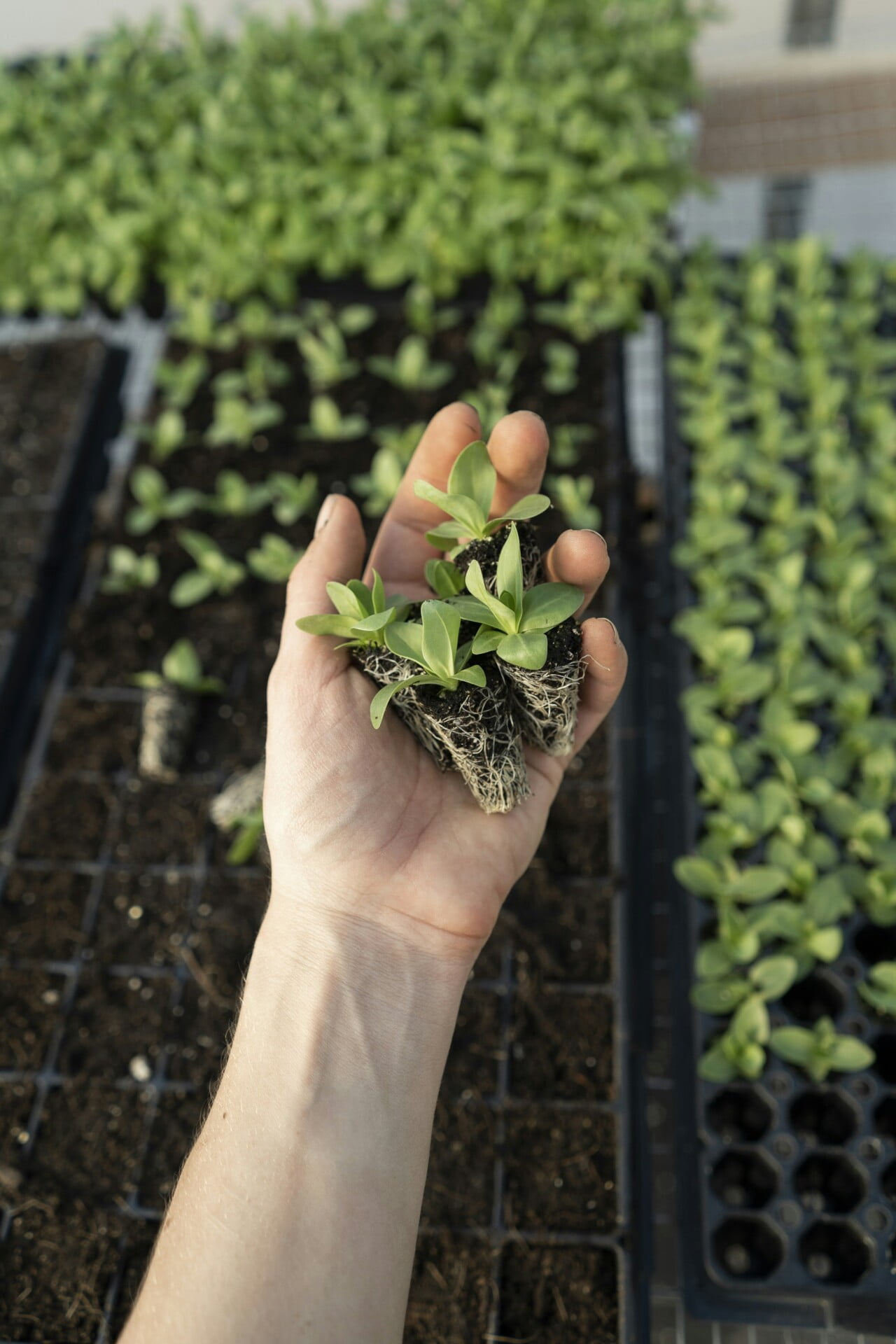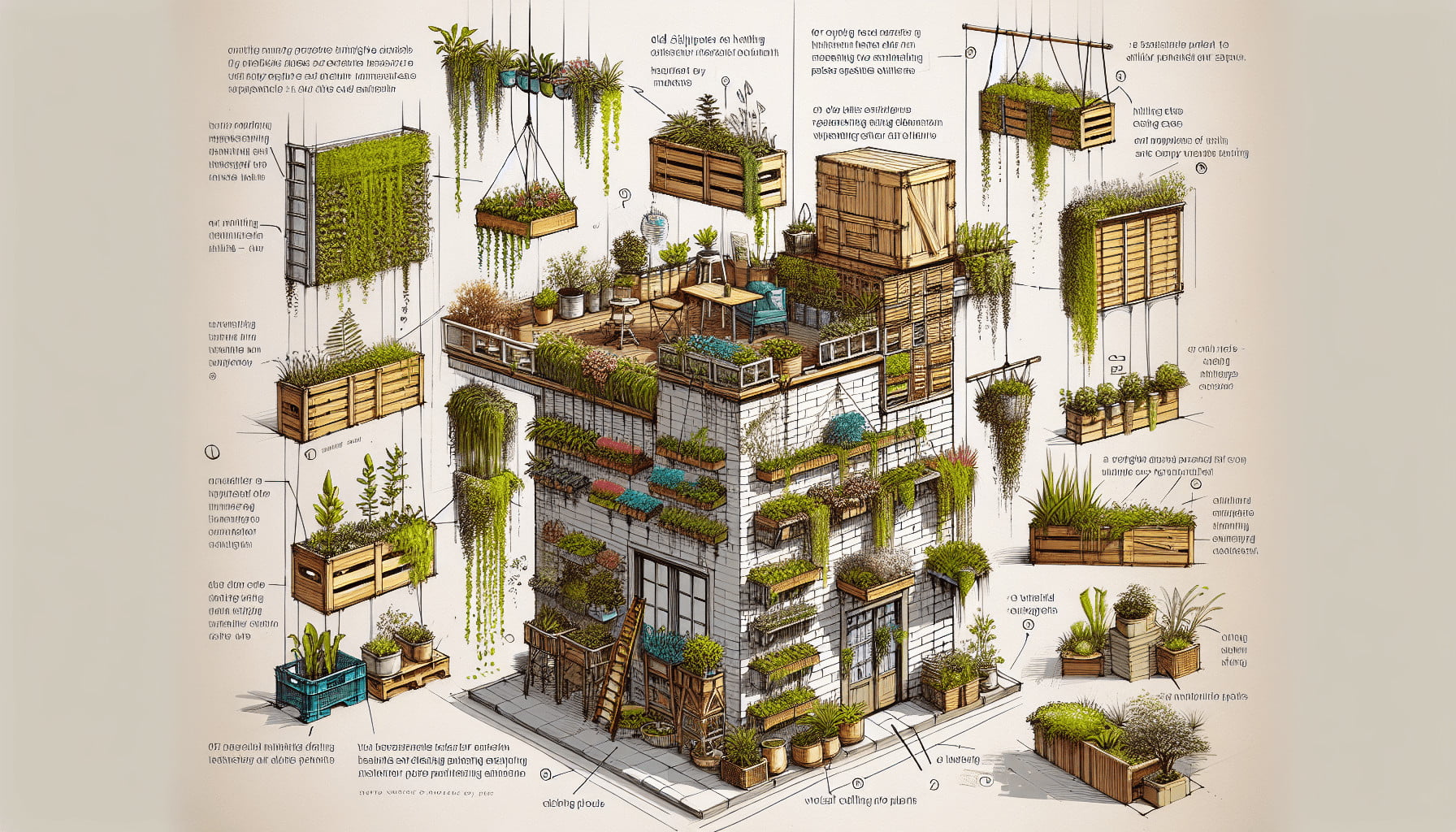If you’re looking to add some greenery and life to your rooftop space, then you’ve come to the right place! In this article, we will explore some creative and innovative ideas for building a vertical garden on your rooftop. Whether you have a small urban oasis or a spacious rooftop terrace, we have got you covered with tips and tricks on how to create your very own vertical garden. So, let’s get started and transform your rooftop into a lush and vibrant sanctuary!
Choose the Right Plants
Consider the climate and sunlight
When choosing plants for your rooftop vertical garden, it is crucial to consider the climate and the amount of sunlight your rooftop receives. Different plants have different sun and temperature preferences, so understanding your rooftop’s microclimate will help you select plants that will thrive. Some plants prefer full sun, while others prefer partial shade. By considering these factors, you can ensure that your plants will receive the optimal amount of sunlight for their growth and health.
Select plants that thrive in vertical gardens
Vertical gardens have unique growing conditions compared to traditional gardens, so it is essential to choose plants that are well-suited for vertical growth. Look for plants that have trailing or cascading habits, as they will gracefully drape down the vertical structure. Consider plants like ivy, ferns, succulents, or trailing flowers such as petunias or nasturtiums. These plants are well-adapted for vertical gardens due to their ability to grow downwards.
Choose a variety of plant types and colors
To create an eye-catching and visually appealing rooftop vertical garden, it is recommended to choose a variety of plant types and colors. By incorporating different plant types, such as flowering plants, foliage plants, and herbs, you can add texture and visual interest to your garden. Additionally, selecting plants with a range of colors, from vibrant blooms to lush greens, can enhance the overall aesthetic appeal and create a stunning display.
Consider the size and weight of the plants
When selecting plants for your rooftop, it is crucial to consider the size and weight of the plants. Ensure that the plants you choose are suitable for vertical growth and won’t overwhelm the structure or put excessive strain on the rooftop. Opt for lightweight containers and compact plant varieties to minimize the load and maintain the structural integrity of your rooftop garden.
Prepare the Rooftop
Check the weight-bearing capacity of the rooftop
Before starting your rooftop vertical garden project, it is essential to check the weight-bearing capacity of your rooftop. Ensure that your rooftop can support the added weight of the plants, containers, and the irrigation system. Consult with a structural engineer or a professional to assess your rooftop’s load-bearing capacity and make any necessary reinforcements before proceeding with your garden installation.
Ensure proper drainage
Proper drainage is critical for the health of your plants and the integrity of your rooftop. Without adequate drainage, excess water can accumulate and cause damage to the rooftop structure. Ensure that your rooftop has appropriate drainage systems in place, such as gutters and downspouts. Additionally, use well-draining soil and incorporate drainage layers in your containers to prevent waterlogging.
Apply a waterproof membrane
To protect your rooftop from water damage, it is essential to apply a waterproof membrane before installing your vertical garden. The membrane will create a barrier that prevents water from seeping into the rooftop and potentially causing leaks. Consult with a professional to determine the most suitable waterproofing method for your specific rooftop.
Install a frame or trellis system
To provide support for your vertical garden, it is necessary to install a frame or trellis system on your rooftop. The frame or trellis will serve as an anchor for your plants and containers. Choose a sturdy and durable material that can withstand outdoor conditions. Ensure that the frame or trellis is securely fastened to the rooftop to prevent any instability or potential damage.

Design the Layout
Plan the arrangement of plants
Designing a thoughtful layout for your rooftop vertical garden is essential for creating an aesthetically pleasing and functional space. Consider the size and growth habits of your chosen plants, arranging them in a way that allows each plant to thrive and show off its unique features. Experiment with different arrangements and layouts to find the one that works best for your rooftop garden.
Consider the height and placement of each plant
When designing your rooftop vertical garden, consider the height of each plant and its placement within the overall arrangement. Place taller plants towards the back or center of the garden to create depth and dimension. Use shorter plants near the edges or in hanging baskets to add interest at eye level. By carefully considering the height and placement of each plant, you can create a visually balanced and appealing vertical garden.
Create a focal point or feature
To add interest and draw attention to your rooftop vertical garden, consider creating a focal point or feature within the design. This could be a tall and dramatic plant, a sculpture, or a decorative element that stands out from the rest of the garden. By incorporating a focal point, you can make your vertical garden more visually engaging and captivating.
Blend different plant species for a harmonious look
To achieve a harmonious and cohesive look in your rooftop vertical garden, blend different plant species together. Choose plants with complementing colors, textures, and growth habits. By combining different plant species, you can create a more dynamic and visually appealing garden that catches the eye and captivates the senses.
Implement Irrigation
Install a drip irrigation system
To ensure proper and efficient watering of your rooftop vertical garden, consider installing a drip irrigation system. Drip irrigation delivers water directly to the roots of plants, reducing water waste and promoting healthy growth. It provides a consistent water supply to each plant while minimizing evaporation and runoff.
Consider automated irrigation timers
Automated irrigation timers can simplify the maintenance of your rooftop vertical garden by providing a set schedule for watering. These timers can be programmed to water your plants at specific times, ensuring they receive regular moisture without the need for constant manual intervention. Consider installing automated irrigation timers to establish a consistent watering routine for your rooftop garden.
Choose a water-efficient system
Incorporating a water-efficient irrigation system is crucial for a sustainable rooftop vertical garden. Opt for systems that minimize water waste and promote efficient water distribution to the plants. Consider using technologies such as moisture sensors or smart controllers that adjust watering based on weather conditions or soil moisture levels.
Ensure proper water distribution to all plants
When designing your irrigation system, ensure that water is evenly distributed to all plants in your rooftop vertical garden. Consider the placement and arrangement of your drip emitters to guarantee that each plant receives sufficient water. Regularly inspect and adjust the irrigation system to ensure proper water distribution and avoid over or under watering.

Enhance with Vertical Structures
Add hanging baskets or pots
To maximize space and add visual interest, incorporate hanging baskets or pots into your rooftop vertical garden. Hanging baskets can be suspended from the trellis or frame, allowing you to grow plants in additional vertical layers. Choose plants with trailing or cascading habits, such as trailing vines or flowering plants, for a beautiful and lush display.
Install vertical planters
Vertical planters are a versatile and space-saving addition to your rooftop garden. These planters can be attached to walls or fences, providing additional growing space for your plants. Explore different types of vertical planters, such as pocket planters or modular systems, to create a striking vertical garden that utilizes every inch of available space.
Use wall-mounted shelves
Wall-mounted shelves are an excellent way to display smaller potted plants, herbs, or decorative elements in your rooftop vertical garden. Install sturdy shelves on the walls or trellis, ensuring they are securely fastened. Displaying plants on shelves adds a layered and dimensional look to your garden while showcasing your favorite plants.
Incorporate trellises and climbing plants
Trellises and climbing plants can add a vertical element and create a sense of height in your rooftop garden. Attach trellises to your vertical garden structure and select climbing plants that are well-suited for your climate and sunlight conditions. Climbing plants, such as clematis, morning glory, or climbing roses, can add a touch of elegance and natural beauty to your rooftop vertical garden.
Utilize Recycled Materials
Repurpose old wooden pallets
Repurposing old wooden pallets is an economical and sustainable way to create unique planters for your rooftop vertical garden. Convert the pallets into vertical growing structures by attaching pots or planting directly into the pallet gaps. Not only does this reuse discarded materials, but it also adds a rustic and creative touch to your garden.
Use recycled plastic containers
Utilize recycled plastic containers as planters for your rooftop vertical garden. Plastic bottles, milk jugs, or food containers can be transformed into innovative and functional planters by adding drainage holes and filling them with soil. By repurposing these containers, you reduce waste and give them a new purpose in your garden design.
Create unique planters from old household items
Think outside the box and get creative by repurposing old household items as unique planters for your rooftop vertical garden. Items such as teapots, boots, or colanders can add whimsy and personality to your garden while providing a home for your plants. Let your imagination run wild and experiment with different repurposed containers to make your rooftop garden truly one-of-a-kind.
Explore DIY options using discarded materials
DIY options using discarded materials offer endless possibilities for your rooftop vertical garden. Salvaged bricks, tiles, or broken concrete pieces can be repurposed as edging or stepping stones in your garden. Old lattice screens or metal grates can be transformed into climbing supports or decorative elements. By exploring DIY options and repurposing discarded materials, you can create a sustainable and environmentally friendly rooftop garden.

Consider Maintenance Needs
Choose low-maintenance plants
To make maintenance easier and more manageable, choose low-maintenance plants for your rooftop vertical garden. Look for plants that require minimal pruning, fertilization, and watering. Consider drought-tolerant plants or native species, as they are typically less demanding in terms of care and maintenance. By selecting low-maintenance plants, you can spend more time enjoying your garden and less time tending to its needs.
Plan for easy access to maintain and prune plants
Ensure that your rooftop vertical garden is easily accessible for maintenance and pruning. Design your garden in a way that allows you to reach all plants without difficulty. Consider installing walkways or platforms that provide easy access to all areas of the garden. By considering accessibility during the design phase, you can ensure that your garden remains beautiful and well-maintained.
Set a regular watering and fertilization schedule
Establishing a regular watering and fertilization schedule is vital for the health and vitality of your rooftop vertical garden. Consistency is key when it comes to watering and providing nutrients to your plants. Set a schedule that suits your plants’ needs and stick to it. Use organic fertilizers and adjust your watering routine based on weather conditions or seasonal changes.
Monitor for pests and diseases
Regularly monitor your rooftop vertical garden for pests and diseases. Inspect your plants for any signs of insect damage or fungal infections. Early detection and intervention can prevent the spread of pests and diseases, ensuring the overall health and longevity of your garden. Use organic pest control methods whenever possible to maintain a safe and chemical-free environment for your plants.
Create a Microclimate
Use windbreakers or screens
Creating a microclimate can help protect your rooftop vertical garden from harsh winds. Install windbreakers or screens around your garden to shield the plants and prevent damage from strong gusts. These barriers can be made from materials like bamboo, fabric, or even strategically placed plants. By creating a wind-protected space, you can provide a more favorable growing environment for your plants.
Utilize shade structures like pergolas or umbrellas
In areas with intense sun exposure, incorporating shade structures like pergolas or umbrellas can create a more comfortable environment for your plants and yourself. Shade structures provide relief from the scorching sun and can help prevent sunburn or dehydration in your rooftop vertical garden. Choose structures that are suitable for your rooftop space and style preferences.
Add misting systems for a cooling effect
During hot summer days, adding misting systems can help cool down your rooftop vertical garden. Misting systems spray a fine mist of water into the air, reducing the ambient temperature and creating a refreshing atmosphere. This cooling effect can benefit both you and your plants, making the rooftop garden a more enjoyable space to spend time in.
Create microhabitats for specific plant preferences
Different plants have different preferences when it comes to temperature, humidity, and sunlight. By creating microhabitats within your rooftop vertical garden, you can accommodate the specific needs of individual plant species. For example, grouping shade-loving plants together in a shaded area or placing sun-loving plants in a sunny spot can ensure optimal growing conditions for each plant.

Include Vertical Garden Accessories
Hang decorative wind chimes or ornaments
To add a touch of whimsy and charm to your rooftop vertical garden, consider hanging decorative wind chimes or ornaments. These delightful accessories not only enhance the aesthetic appeal of your garden but also create soothing sounds when there’s a gentle breeze. Choose designs that complement your garden’s style and evoke a sense of tranquility.
Add string lights or lanterns
String lights or lanterns can transform your rooftop vertical garden into a magical and enchanting space, especially during the evening. These lighting accessories add warmth and ambiance, illuminating your garden and creating a cozy atmosphere. Choose energy-efficient LED lights or solar-powered options for an eco-friendly lighting solution.
Incorporate seating or a small table for enjoyment
Make your rooftop vertical garden a comfortable and inviting space by incorporating seating or a small table. This allows you to relax and enjoy the beauty of your garden while sipping a cup of tea or reading a book. Choose furniture that is weather-resistant and suitable for outdoor use. Create a cozy nook within your garden to unwind and soak up the tranquility of your rooftop oasis.
Install a small water feature for ambiance
To enhance the soothing atmosphere of your rooftop vertical garden, consider installing a small water feature. A miniature fountain or a tranquil water wall can add a sense of serenity to your garden, creating a calming backdrop and masking any urban noise. The gentle sound of flowing water can promote relaxation and bring a sense of harmony to your rooftop escape.
Maintain Sustainability
Use organic fertilizers and pesticides
Maintaining sustainability in your rooftop vertical garden involves choosing eco-friendly fertilizers and pesticides. Opt for organic options, which are derived from natural sources and free from harmful chemicals. Organic fertilizers nourish the soil and provide essential nutrients to your plants, while organic pesticides protect against pests without causing harm to beneficial insects or the environment.
Collect and reuse rainwater
Maximize sustainability by collecting and reusing rainwater in your rooftop vertical garden. Install a rainwater harvesting system to capture and store rainwater for future use. Rainwater is free of chemicals and is an excellent source of hydration for your plants. By utilizing this natural resource, you can reduce reliance on municipal water supplies and promote water conservation.
Compost organic waste for natural fertilizer
Turn kitchen scraps and garden waste into nutrient-rich compost to feed your rooftop vertical garden. Composting organic waste transforms it into a valuable natural fertilizer that enriches the soil and enhances plant growth. Establish a composting system on your rooftop, utilizing compost bins or worm farms to create a sustainable and circular ecosystem.
Choose native or drought-tolerant plants
Incorporating native or drought-tolerant plants in your rooftop vertical garden promotes sustainability by reducing water consumption and maintenance requirements. Native plants are well-adapted to the local climate and require minimal intervention once established. Drought-tolerant plants have evolved to thrive in dry conditions, making them resilient and less demanding in terms of watering. By selecting plants that are naturally suited to your environment, you can build a more sustainable garden.
Creating a rooftop vertical garden is an exciting and creative way to make the most of your outdoor space. By following these guidelines and incorporating these ideas, you can design and build a stunning and sustainable garden that will be the envy of your neighborhood. Enjoy the process and let your imagination run wild as you transform your rooftop into a lush and vibrant oasis. With careful planning and maintenance, your rooftop vertical garden will thrive, bringing beauty, tranquility, and a touch of nature to your urban dwelling.

